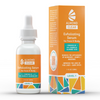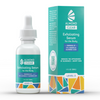The Science Behind Mandelic Acid
Okay, lean in…. let me tell you a little secret about most of the skincare articles that you read online. Have you ever noticed how they all sound similar and repeat the same information over and over? It’s almost as if the authors are copying each other, and the secret is that copying is exactly what’s happening. People regurgitate the same information over and over again from one website and blog post to another until it’s impossible to tell where any of the “facts” came from or if these “facts” are even true. That’s exactly what’s happening with information about mandelic acid (MA).
So what’s true about mandelic acid and what’s just hearsay, and where did all of these claims about MA’s amazing properties really come from? As the founder of a line of skincare products that are powered by mandelic acid, I wanted to know the truth, so I spent a lot of time digging up the scientific research on mandelic acid.
I did this research with three purposes in mind:
- To collate peer-reviewed research about mandelic acid’s effects on the skin into one place so that anyone who’s searching online can find reliable information
- To locate the sources for the common online claims that are made about mandelic acid
- To confirm that research shows that MA works for a variety of skin concerns, or to find places where the research refutes the efficacy of MA
I learned a lot from this process, so here’s how I’ll organize my findings:
- CLAIM: I’ll name a commonly repeated claim about mandelic acid
- WHO CARES?: I’ll explain why this claim matters- what’s at stake if this is true or false?
- RELEVANT RESEARCH: I’ll cite the research that supports or refutes this claim
- SUMMARY: I’ll briefly summarize the findings.
- TAKEAWAY: If the research has any big takeaways, then I’ll try to make them crystal clear
CLAIM: Mandelic acid is both antibacterial and antifungal.
WHO CARES?: If it’s true that MA is both antibacterial and antifungal, then it is likely that MA application can clear up both bacterial and fungal folliculitis. It’s also reasonable to conclude that it can kill the bacteria that causes acne to become inflamed, and reduce the severity of acne.
No other skincare acid has been shown to have antifungal properties, so if mandelic acid is indeed antifungal, then it would be unique among skincare acids.
RELEVANT RESEARCH:
-
Antimicrobial Activity of Mandelic Acid Against Methicillin-Resistant Staphylococcus aureus: a Novel Finding with Important Practical Implications
- Microbiological Evaluation and Preservative Efficiency of New Mandelic Acid Derivatives in Ointments
SUMMARY:
Study #1 tested out whether mandelic acid has any antibacterial activity against MRSA, a dangerous form of staph bacteria that can infect the skin and body and can be very difficult to treat. The study’s conclusion states that mandelic acid does indeed have antibacterial properties against MRSA, and the scientists suggested that MA could be used as a moisturizer for the skin to stop MRSA from spreading between people.
TAKEAWAY: Mandelic acid is antibacterial! Good news for people suffering from both acne and folliculitis.
Study #2 tested if mandelic acid has both antibacterial and antifungal properties. The scientists were wondering if MA could be used in Petri dishes as a preservative to keep bacteria and fungus from growing. They let specific strains of bacteria and fungus grow in Petri dishes, then inserted a disc containing mandelic acid. They looked to see if MA killed the bacteria and fungus, and they found that it did! Check out a screenshot of their results below!

TAKEAWAY: Mandelic acid is indeed antifungal (excellent news for people suffering from pityrosporum folliculitis)! Another important finding is that mandelic acid has antibacterial properties for both gram-positive and gram-negative forms of bacteria, which points towards it being an effective product for both acne and bacterial folliculitis.
CLAIM: Mandelic acid is a “miracle” for clearing up acne, especially for people of color
WHO CARES? There are lots of online reports of mandelic acid clearing up people’s acne. You can find tons of testimonials from people whose skin is now clear due to MA (and of course there are others who report that it didn’t work for them at all). If research shows that mandelic acid is an effective treatment for acne, then it could be a great treatment option and a strong alternative to more traditional treatments like salicylic acid and benzoyl peroxide.
Another huge “who cares” is that many people claim that mandelic acid is a superior choice for people of color who suffer from acne. They say that other products like benzoyl peroxide and glycolic acid can cause skin damage that leads to post-inflammatory hyperpigmentation (dark spots). Many people claim that mandelic acid does not cause skin darkening, and if true, this would be a bid deal because dark spots and scarring are common skin concerns for people of color.
RELEVANT RESEARCH:
-
Evaluation of the efficacy and tolerability of mandelic acid-containing cosmetic formulations for acne skin care
- Mandelic acid chemical peel in Acne vulgaris: A boon or a bane?
- Glycolic Acid Peels Versus Salicylic-Mandelic Acid Peels in Active Acne Vulgaris and Post-Acne Scarring and Hyperpigmentation: A Comparative Study
SUMMARY:
The goal of study #1 was to test if mandelic acid is a good treatment option for acne. The researchers tested both 5% and 10% mandelic acid on 60 people who suffer from papulo-pustular acne. The research subjects applied mandelic acid for two months. The study found that both 5% and 10% mandelic acid caused a gradual improvement in all types of acne (nodules, pustules, and comedones). They concluded that mandelic acid appears to be safe and effective for the treatment of acne.
TAKEAWAY: This study showed that mandelic acid works to gradually clear moderate acne!

Papulo-pustular acne
Image credit: https://images.emedicinehealth.com/images/4453/4453-13248-20010-22040.jpg
Study #2 and #3 had the same underlying question. Is mandelic acid a safe and effective acne treatment option for people of color? These studies were both conducted in India, where it’s common for people to have highly pigmented skin.
Study #2’s conclusion states, “In our study, lower concentration mandelic acid proved to be safe and effective in Indian population with darker skin types, with fewer side effects which were short-lived and preventable” (Jartarkar et al, 2015). They saw good improvement in both non-inflammatory and inflammatory acne, and they suggested that mandelic acid likely has anti-inflammatory and antibacterial properties. They also found that MA was well-tolerated, with patients developing no hyperpigmentation, crusting, or blistering, and very little erythema (reddening of the skin).
TAKEAWAY: For people of color, mandelic peels were shown to improve acne without some of the common side effects that can be troublesome for highly pigmented skin, like hyperpigmentation, excessive dryness, and reddening.


Image credit: http://www.iosrjournals.org/iosr-jdms/papers/Vol14-issue5/Version-7/I014573235.pdf
For our purposes, study #3 is a little trickier to interpret because it only examined how mandelic performs when combined with salicylic acid. It compared how two different types of peels performed for the treatment of acne of Indian descent. The first type of peel was made with glycolic acid, and the second peel was a blend of salicylic and mandelic acids. The researchers found that both peels were effective, but the salicylic-mandelic blend was more effective for clearing up hyperpigmentation (acne scars). They concluded that both types of peels are effective and safe for Indian patients, with salicylic-mandelic being better for post-acne hyperpigmentation.
TAKEAWAY: A blend of salicylic and mandelic acids works well to clear acne and post-acne scarring and can be a good choice for people with highly pigmented skin. The results also showed that glycolic acid also works to clear acne, but it tended to produce more temporary skin damage and less clearing of hyperpigmentation than MA.
Another important takeaway is that MA appears to reduce dark scarring and hyperpigmentation.
CLAIM: Mandelic acid reduces fine lines and wrinkles and firms the skin
WHO CARES?: People aren’t just interested in mandelic acid for its blemish-clearing properties. Many people purchase MA for its reported abilities to reduce the signs of aging and sun damage. Also, for people who suffer from adult acne or folliculitis, MA could be a multi-tasking skin treatment, clearing up both blemishes and wrinkles with one product.
RELEVANT RESEARCH:
SUMMARY:
In this study, 24 patients applied mandelic acid twice a day over a period of four weeks. The researchers measured the lower eyelid skin viscoelastic properties. “Viscoelastic” is not a word that I’m familiar with, and I’m guessing that it’s not in your every-day vocabulary either, so I did looked it up. It looks like the scientists were stretching people’s eyelid skin and then measuring if it could quickly return to its original shape or not. Viscoelasticity is how quickly and completely the skin returns to its original state once stretched. This is important because younger skin is more elastic and firm. Here’s what the researchers found:
“After four weeks of topical mandelic acid treatment, the elasticity of lower eyelid skin increased 25.4% (P = .003). Skin firmness increased 23.8% (P = .029). Improvement in photographic appearance correlated with these findings. Mandelic acid is another topical treatment option for improving skin quality, and is well tolerated by patients. ” (Jacobs SW, Culbertson EJ, 2018).
TAKEAWAY:
Mandelic acid was shown to improve two of the major signs of aging skin: elasticity and firmness!
My Final thoughts
The research that I was able to find all supports the common claims made about mandelic acid. However, MA has been studied a lot less than other topical skin care products, and it seems pretty clear that more research is needed to further support or refute the findings of the studies that have been done so far.
If you come across any peer-reviewed research on mandelic acid and skincare, then please, please, please email me or post a comment! I am not looking for research that’s been done by biased dermatologists who sell their own MA skincare products, and I’m also not interested in studies with very small sample sizes because these kinds of studies aren't very reliable. What I am looking for is research that’s been peer-reviewed.
I hope that this blog post can act as a public space for research about mandelic acid so that we can separate the truth from the hype, or else maybe confirm that the hype is well-founded. I’m looking forward to growing this mandelic acid resource with your help!
Like what you read? Want to chat about skincare with people who have the same skin concerns as you? Join our Facebook Group- Almond Clear Skincare Support.








